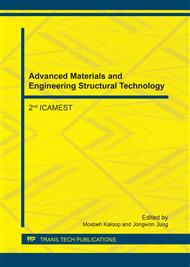[1]
A. Brecht, G. Gauglitz, J. Polster, Interferometric immunoassay in a FIA-system: a sensitive and rapid approach in label-free immunosensing, Biosens. Bioelectron. 8(7) (1993) 387-392.
DOI: 10.1016/0956-5663(93)80078-4
Google Scholar
[2]
S. Chan, P. Fauchet, Y. Li, L. Rothberg, B. Miller, Porous silicon microcavities for biosensing applications, Phys. Status Solidi A, 182(1) (2000) 541-546.
DOI: 10.1002/1521-396x(200011)182:1<541::aid-pssa541>3.0.co;2-#
Google Scholar
[3]
J. Lu, C. M. Strohsahl, B. L. Miller, L. J. Rothberg, Reflective interferometric detection of label-free oligonucleotides, Anal. Chem. 76(15) (2004) 4416-4420.
DOI: 10.1021/ac0499165
Google Scholar
[4]
V. Lin, K. Motesharei, K. Dancil, M. Sailor, M. Ghadiri, A porous silicon-based optical interferometric biosensor, Science 278(31) (1997) 840-843.
DOI: 10.1126/science.278.5339.840
Google Scholar
[5]
R. Beranek, H. Hildebrand, P. Schmuki, Self-organized porous titanium oxide prepared in H2SO4/HF electrolytes, Electrochem. Solid-State Lett. 6(3) (2003) B12-B14.
DOI: 10.1149/1.1545192
Google Scholar
[6]
J. M. Macak, H. Tsuchiya, P. Schmuki, High‐Aspect‐Ratio TiO2 Nanotubes by Anodization of Titanium, Angew. Chem. Int. Ed. 44(14) (2005) 2100-2102.
DOI: 10.1002/anie.200462459
Google Scholar
[7]
K. S. Mun, S. D. Alvarez, W. Y. Choi, M. J. Sailor, A stable, label-free optical interferometric biosensor based on TiO2 nanotube arrays, Acs Nano, 4(4) (2010) 2070-(2076).
DOI: 10.1021/nn901312f
Google Scholar
[8]
D. J. Yang, H. G. Kim, S. J. Cho, W. Y. Choi, Thickness-conversion ratio from titanium to TiO2 nanotube fabricated by anodization method, Mater. Lett. 62(4) (2008a) 775-779.
DOI: 10.1016/j.matlet.2007.06.058
Google Scholar
[9]
D. J. Yang, H. G. Kim, S. J. Cho, W. Y. Choi, Vertically oriented titania nanotubes prepared by anodic oxidation on Si substrates, IEEE Trans. Nanotechnol. 7(2) (2008b) 131-134.
DOI: 10.1109/tnano.2007.909439
Google Scholar
[10]
M. P. Schwartz, S. D. Alvarez, M. J. Sailor, Porous SiO2 interferometric biosensor for quantitative determination of protein interactions: binding of protein A to immunoglobulins derived from different species, Anal. Chem. 79(1) (2007) 327-334.
DOI: 10.1021/ac061476p
Google Scholar
[11]
L. Taveira, J. Macak, H. Tsuchiya, L. Dick, P. Schmuki, Initiation and Growth of Self-Organized TiO2 Nanotubes Anodically Formed in NH4F∕(NH4)2SO4 Electrolytes, J. Electrochem. Soc. 152(10) (2005) B405-B410.
DOI: 10.1149/1.2008980
Google Scholar
[12]
T. Güthner et al., 7th ed., Guanidine and Derivatives, Ullman's Encyclopedia of Industrial Chemistry, Wiley, 2007 p.13.
Google Scholar


